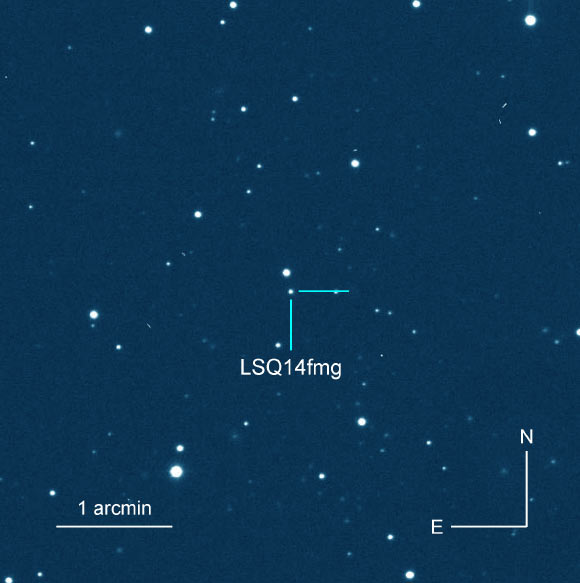
Astronomers Observe Slowest Rising Type Ia Supernova Ever Seen | Astronomy
The exaggerated properties of a Type Ia supernova dubbed SN LSQ14fmg may help reveal the origin of the super-Chandrasekhar group of supernovae it belongs to, according to new research published in the Astrophysical Journal.SN LSQ14fmg exploded in SDSS J221646.15+152114.2, a star-forming galaxy 100 million light-years away. Image credit: Hsiao et al, doi: 10.3847/1538-4357/abaf4c.Type Ia supernovae were crucial tools for discovering whats known as dark energy, which is the name given to the unknown energy that causes the current accelerated expansion of the Universe.Despite their importance, astronomers knew little about the origins of these supernova explosions, other than that they are the thermonuclear explosions of white dwarf stars.But Florida State Universitys Dr. Eric Hsiao and his colleagues knew that the light from a Type Ia supernova rises and falls over the course of weeks, powered by the radioactive decay of nickel produced in the explosion.A supernova of that type would get brighter as the nickel becomes more exposed, then fainter as the supernova cools and the nickel decays to cobalt and to iron.After collecting data with telescopes in Chile and Spain, the astronomers saw that SN LSQ14fmg was hitting some material surrounding it, which caused more light to be released along with the light from the decaying nickel. They also saw evidence that carbon monoxide was being produced.This was a truly unique and strange event, and our explanation for it is equally interesting, Dr. Hsiao said.The researchers think that SN LSQ14fmg was exploding inside what had been an asymptotic giant branch (AGB) star on the way to becoming a planetary nebula.Seeing how the observation of this interesting event agrees with the theory is very exciting, said Jing Lu, a doctoral candidate at Florida State University.They theorize that the explosion was triggered by the merger of the core of the AGB star and another white dwarf star orbiting within it.The central star was losing a copious amount of mass through a stellar wind before the mass loss was turned off abruptly and created a ring of material surrounding the star.Soon after the supernova exploded, it impacted a ring of material often seen in planetary nebulae and produced the extra light and the slow brightening observed.This is the first strong observational proof that a Type Ia supernova can explode in a post-AGB or proto-planetary-nebula system and is an important step in understanding the origins of Type Ia supernovae, Dr. Hsiao said.These supernovae can be particularly troublesome because they can mix into the sample of normal supernovae used to study dark energy.This research gives us a better understanding of the possible origins of Type Ia supernovae and will help to improve future dark energy research._____E.Y. Hsiao et al. 2020. Carnegie Supernova Project II: The Slowest Rising Type Ia Supernova LSQ14fmg and Clues to the Origin of Super-Chandrasekhar/03fg-like Events. ApJ 900, 140; doi: 10.3847/1538-4357/abaf4c
……
Comments
Leave a comment in Nestia App